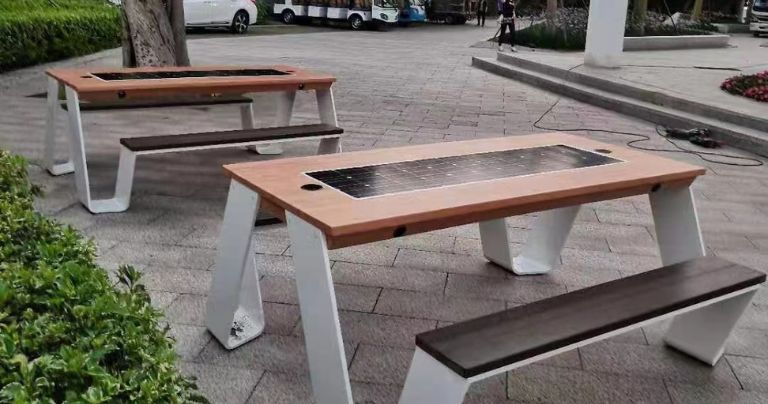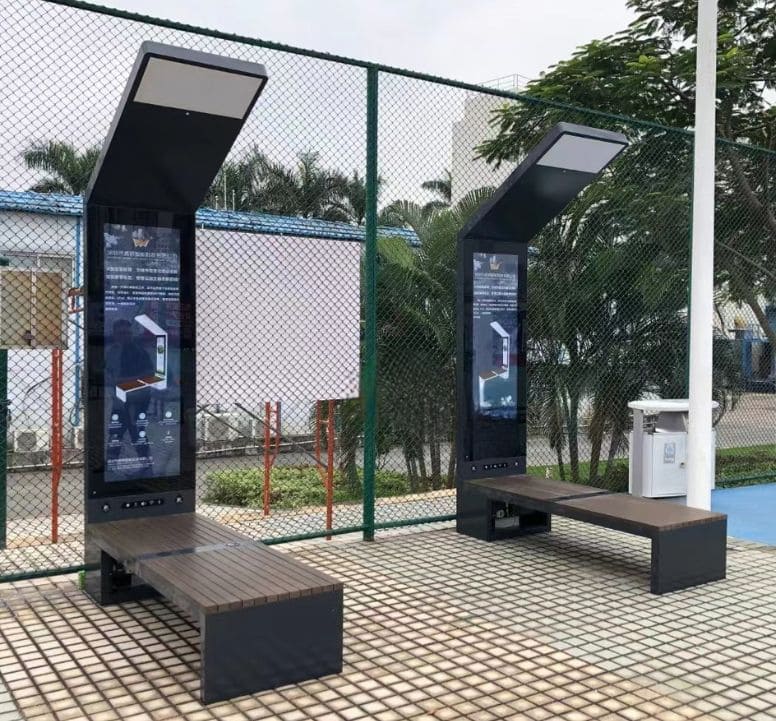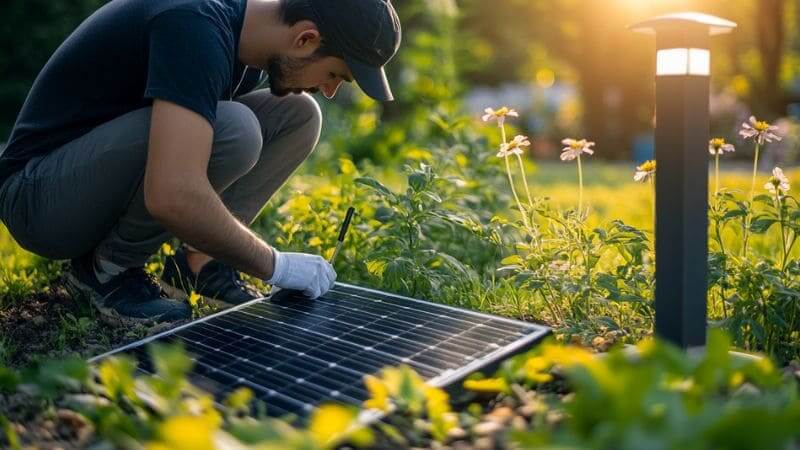In the bustling world of urban development, I often find myself at the crossroads of innovation and practicality. As a business owner and procurement officer, my mission is to enhance public spaces with technology that marries functionality with cost-efficiency. Smart benches have emerged as a cornerstone in this quest, offering a blend of convenience and sustainability.
As we step into 2023, we’re all asking: How will smart benches change our public spaces? I’ve spent years finding the best equipment for our cities, and I believe the secret is simple. It’s about smart design that brings people together and fits our budgets. Solar-powered, tech-smart benches are more than just a place to sit—they’re the future of our parks and streets, affordable and built for everyone.
The landscape of public amenities is evolving, and with it, the expectations of those who use them. It’s not just about having a place to sit anymore; it’s about staying connected, charged, and sheltered by the sustainable power of the sun.
What Are the Must-Have Features of a Smart Bench in 2023?
In 2023, the evolution of public seating into ‘smart benches’ is not just a trend, it’s a necessity. These benches are no longer mere rest stops; they are the nexus of convenience and sustainability. Let’s delve into the essential features that define the smart benches of today, transforming our public spaces into connected, eco-friendly, and technologically advanced havens.
Solar Charging: The Powerhouse of Convenience
The cornerstone of a modern smart bench is its solar charging capability. As our lives become increasingly mobile, public spaces must adapt to serve as power sources. The solar benches of 2023 are equipped with high-efficiency solar panels, boasting impressive photoelectric conversion rates. This means that even on overcast days, these benches are more than capable of harnessing solar energy to keep the public connected.
Connectivity and Comfort: Beyond Just a Seat
Connectivity is another non-negotiable feature. The latest models come with multiple charging ports, catering to a variety of devices, and offer wireless charging at a minimum of 30W. This is not just a convenience but a beacon for the tech-savvy and the busy pedestrian alike, providing a quick charge and a moment of respite.
Eco-Friendly Materials: The Green Standard
In line with global sustainability goals, the materials used in smart benches are as important as the technology they house. Eco-friendly and recycled materials are now standard in bench construction, reducing the carbon footprint and ensuring that these public amenities are in harmony with environmental conservation efforts.
Durability and Design: Built to Last
Durability is paramount. These benches are designed to withstand the rigors of public use and the unpredictability of weather. Anti-vandalism features and weather-resistant materials are integral, ensuring that these smart benches remain functional and aesthetically pleasing for years to come.
User Experience: Smart and Intuitive
User experience is at the heart of smart bench design. Intuitive interfaces, ambient LED lighting for safety and comfort, and even Wi-Fi connectivity turn a simple bench into a smart hub. These features not only enhance the user’s experience but also encourage longer stays within public spaces, fostering community engagement.
Accessibility: Inclusive Design for All
Finally, smart benches in 2023 are designed with accessibility in mind. They are not just for the able-bodied but are crafted to be inclusive, with features that cater to all demographics, including the elderly and disabled, ensuring that everyone has access to the smart features and the comfort they provide.
The solar benches of today are a testament to how far we’ve come in integrating technology into our daily lives. They are a blend of functionality, design, sustainability, and user experience, all wrapped up in an economically viable package. As we continue to innovate, these benches will not only be a common sight but a crucial element in the smart cities of the future.
How Does Design and Durability Influence Your Solar Bench Purchase?
In the realm of public amenities, the purchase of a solar-powered bench is heavily influenced by its design and durability. As a procurement specialist and the mind behind SolaraNook, I place immense value on these aspects. They are not mere details but the foundation of a smart bench’s lifespan and its ability to blend into the communal tapestry.
Aesthetic Appeal Meets Enduring Substance
A solar charging bench must be more than just functional; it must also complement the environment it inhabits. A sleek, contemporary design that appeals to the public eye is essential. However, the true essence of a well-designed smart bench lies in its resilience. The use of weather-resistant materials and anti-vandalism features ensures that these benches stand the test of time and remain as fixtures of utility and beauty in our public spaces.
Customization: The Key to Versatility
Customization is the secret ingredient that allows smart benches to serve diverse communities effectively. By incorporating adjustable features such as LED lighting for visibility and ambiance, and technological add-ons like Wi-Fi and Bluetooth connectivity, a smart bench can be transformed to meet the specific demands of any locale, making it a versatile asset in any urban landscape.
In essence, the design and durability of a smart bench are pivotal in the purchasing decision. They dictate not only the longevity of the bench but also its ability to enhance the user experience and integrate seamlessly into various public settings. It is this combination of robust construction and thoughtful design that makes a smart bench a wise investment for the future of our cities.
What Role Does Cost Play in the Selection of a Smart Bench?
In the procurement of smart public benches, cost is not just a line item; it’s a pivotal factor that can sway decision-making. As a business owner, I’m acutely aware that every dollar spent is an investment, and the true cost of a smart bench goes beyond its price tag. It’s a delicate balance to strike—ensuring that the investment reaps tangible benefits for the community without straining the budget.
Initial Investment vs. Long-Term Savings
The upfront cost of a smart bench, particularly one outfitted with the latest technology, can be substantial. However, this initial investment is mitigated by the long-term savings it offers. Smart benches, with their solar-powered capabilities, eliminate ongoing electricity costs. Their durable design minimizes the need for frequent repairs or replacements. It’s this foresight in planning and budgeting that ensures a smart bench is a cost-effective addition to any public space.
Operational Efficiency: The Hidden Value
Operational costs are often the unseen iceberg in the sea of procurement. Solar charging benches shine in this aspect, as they are designed to be low-maintenance and self-sufficient. The savings in energy and maintenance costs over time are significant, contributing to a lower total cost of ownership and a more attractive ROI.
The Price of Innovation
Innovation comes at a price, but it’s a price worth paying when the value is clear. The features of a smart bench—such as wireless charging, internet connectivity, and environmental sensors—add value to the user experience and to the community at large. This value must be weighed against the cost to determine the true worth of the investment.
So the cost plays a dual role in the selection of a smart bench. It’s not just about the affordability but also about the value it brings over its lifetime. A smart bench is a statement of a city’s commitment to innovation, sustainability, and the well-being of its citizens. As such, the cost is a consideration, but one that is balanced by the considerable benefits these benches provide.
How Can Smart Benches Address the Pain Points of High MOQ and Customization?
High MOQs and rigid customization options often stand as formidable barriers, especially for entities with limited resources or those experimenting with new technologies. Smart benches, with their innovative approach, present a solution to these challenges, offering flexibility and tailored features that cater to diverse public needs and procurement strategies.
Lower MOQs: A Gateway to Innovation for All
The requirement for high MOQs can stifle the adoption of new technologies by smaller municipalities or organizations. Smart benches are changing the game by offering lower MOQ options, thus democratizing access to advanced urban furniture. This flexibility allows for a more inclusive approach, enabling smaller entities to partake in the smart city movement without the pressure of a hefty initial investment.
Customization: Meeting the Community’s Unique Needs
Customization is not just a luxury; it’s a necessity in addressing the specific needs of different communities. Public smart benches rise to the occasion with adaptable features such as adjustable charging ports, various connectivity options, and ambient lighting. These customizable elements ensure that each smart bench can serve its intended purpose, whether it’s in a quiet park or a bustling city square.
The Ripple Effect of Flexible Procurement
By addressing the pain points of high MOQ and limited customization, smart benches not only provide a practical solution but also create a ripple effect of benefits. They encourage innovation, foster inclusivity, and ensure that the needs of the community are met. This flexibility in procurement translates into public spaces that are more connected, more sustainable, and more in tune with the needs of their users.
In essence, smart benches are paving the way for a new era of urban furniture procurement—one that is characterized by lower barriers to entry and a higher degree of personalization. As we move forward, these benches will not only be a fixture in our public spaces but also a testament to the evolving nature of city planning and community engagement.
How Does Technology Integration Enhance the Functionality of Smart Benches?
In today’s urban landscape, the integration of technology into public amenities is not just a trend—it’s a transformative movement. Solar charging benches are at the forefront of this shift, enhancing the functionality of traditional public seating through advanced technology. This integration is pivotal, turning every bench into a node within the larger smart city network.
Data-Driven Insights for Improved Urban Living
The true power of technology integration lies in data. Smart benches equipped with sensors can track usage patterns, solar charging efficiency, and even environmental conditions. This data is invaluable, providing city planners with real-time insights that inform maintenance schedules, energy management, and urban development strategies. It’s a leap towards proactive, rather than reactive, city management.
IoT Connectivity: The Pulse of Public Spaces
The Internet of Things (IoT) has revolutionized how we interact with our environment, and smart benches are a prime example. By incorporating IoT technology, these benches become more than just a place to sit—they transform into interactive hotspots. Users can access city services, stay informed about local events, and receive important alerts. This connectivity not only enhances the user experience but also weaves a fabric of communication throughout the city.
Fostering Community Through Technology
Solar-powered benches also play a crucial role in fostering community. They provide a platform for residents and visitors to engage with their surroundings and with each other. With features like Wi-Fi access and charging ports, they encourage people to gather, interact, and stay longer in public spaces, strengthening the sense of community.
In summary, the integration of technology into smart benches significantly enhances their functionality. It’s an investment in a more efficient, connected, and responsive urban environment. As we continue to innovate, these benches will serve as more than just a place to rest—they will be a cornerstone of smart city infrastructure, enriching the lives of citizens and the communities they inhabit.
What Sustainability Factors Should Be Considered When Purchasing Smart Benches?
In the era of environmental consciousness, sustainability is not just a buzzword—it’s a commitment. When it comes to outfitting public spaces with smart benches, this commitment translates into a series of eco-friendly considerations that extend beyond the product’s functionality and into its life cycle and impact on the planet.
Harnessing Solar Energy: A Step Towards Renewable Solutions
The integration of solar panels into smart benches is a testament to innovation in renewable energy use in public infrastructure. These benches do more than offer a quick charge for devices; they embody the principle of sustainable living by utilizing the abundant power of the sun. This not only reduces the carbon footprint but also aligns with global efforts to combat climate change.
Material Matters: The Environmental Impact of Production
The choice of materials in the manufacturing of smart benches is a significant sustainability factor. Opting for recycled materials not only minimizes waste but also sets a precedent for responsible production practices. Furthermore, selecting materials that are durable and require less frequent replacement reduces environmental impact over the bench’s lifespan.
End-of-Life Considerations: Closing the Loop
A sustainable product is one that considers its end-of-life impact. Smart benches designed for easy disassembly allow for parts to be recycled or repurposed, minimizing waste and promoting a circular economy. This forward-thinking approach ensures that the benches contribute positively to the environment throughout their life cycle.
The Broader Picture: Sustainable Manufacturing Processes
Beyond the benches themselves, the manufacturing processes also come under scrutiny. Facilities that utilize green manufacturing techniques and prioritize energy efficiency contribute to the overall sustainability of the smart benches they produce.
Wwhen purchasing smart benches, it’s crucial to consider the full spectrum of sustainability factors. From solar energy utilization and material selection to end-of-life disassembly and manufacturing processes, each element plays a role in ensuring that these modern amenities contribute to a greener, more sustainable future. As we continue to innovate, let us also ensure that we do so responsibly, with an eye on the well-being of our planet.
Conclusion
In the quest for smart urban solutions, benches that offer a combination of innovative features and cost-effectiveness are leading the way. By addressing the specific needs of the community and ensuring that investments are future-proof, we can create public spaces that are not only smart but also inclusive and sustainable.










